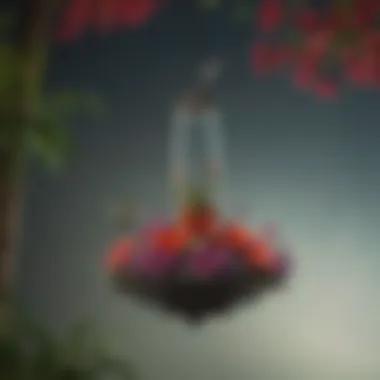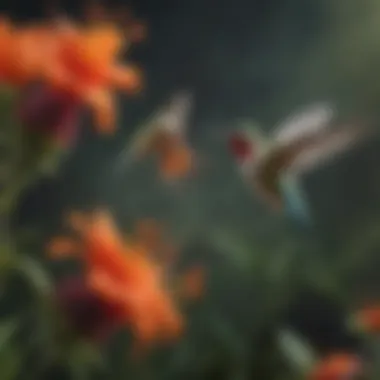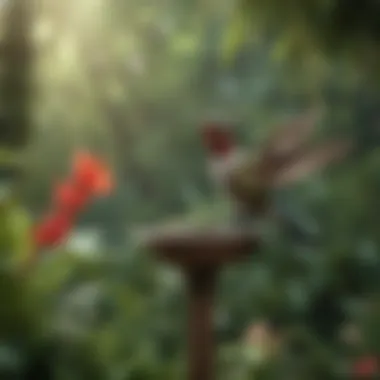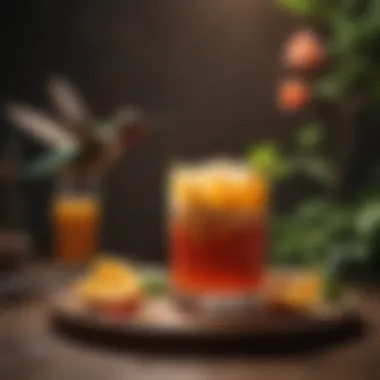Exploring Hummingbird Feeding Stations in Depth


Intro
Hummingbirds are graceful creatures, often seen flitting from flower to flower. They are not just beautiful but play a crucial role in pollination, making them significant in our ecosystems. Observing these birds can be a delight, but attracting them requires more than just hope. Setting up a hummingbird feeding station can enhance your garden’s appeal while providing these birds with essential nourishment.
In this article, we will explore the intricate aspects of hummingbird feeding stations. From design inspirations to maintenance tips, you will gain a comprehensive understanding of how to create an inviting environment for these remarkable birds. With careful planning and execution, your garden can become a haven for hummingbirds, allowing you to enjoy their presence while contributing to their well-being.
Prelims to Hummingbird Feeding Stations
Hummingbird feeding stations play a critical role in promoting biodiversity in our gardens and outdoor spaces. These structures not only serve as food sources for the beautiful and agile hummingbirds, but they also create an opportunity for homeowners to engage with nature in a meaningful way. Understanding the importance of these feeding stations can illuminate how they enhance our surroundings and contribute to ecology.
Understanding Hummingbirds
Hummingbirds are tiny wonders of nature, known for their vibrant colors and remarkable flying abilities. There are over 300 species of hummingbirds, primarily found in the Americas. Each species has unique traits, yet they all share common feeding habits. Hummingbirds feed on nectar, which provides them with the energy required for their rapid wing beats and agile flight. They also require protein, which they get from insects and spiders.
These birds are highly skilled pollinators. As they travel from flower to flower to gather nectar, they inadvertently transfer pollen, which helps in plant reproduction. This relationship further underscores the advantage of providing hummingbird feeding stations. When designed correctly, these stations complement the plants in your garden, attracting even more hummingbirds and promoting local flora.
The Importance of Feeding Stations
Feeding stations are not just a luxury for hummingbirds; they are vital for their survival, especially in areas where natural nectar sources are scarce. The importance can be summarized in several key points:
- Sustenance During Migration: Many hummingbird species migrate long distances. Feeding stations provide essential nutrients during these arduous journeys.
- Breeding Support: During the breeding season, female hummingbirds require ample energy to nurture their young. Offering feeding stations supports this critical phase.
- Research and Observation: Setting up a feeder allows birdwatchers and researchers alike to study hummingbird behaviors and interactions closely. This contributes to citizen science and a broader understanding of these unique creatures.
Types of Hummingbird Feeding Stations
Hummingbird feeding stations are essential tools for attracting these agile birds to gardens and outdoor spaces. The types of feeders available can significantly affect the hummingbirds' feeding behavior, engagement, and the overall efficacy of the feeding station. Understanding these different types contributes to better management and enhances the enjoyment of observing these creatures.
Sugar Water Feeders
Sugar water feeders are the most common and widely used type of hummingbird feeders. They typically contain a mixture of sugar and water, mimicking the natural nectar found in flowers. This solution not only provides the necessary energy for hummingbirds but also encourages frequent visits, leading to greater interaction for bird watchers.
When using sugar water feeders, it is important to follow some basic guidelines to ensure the best results:
- Ratio of sugar to water: A common ratio is one part sugar to four parts water. This mixture offers a balanced solution for hummingbirds.
- Avoiding additives: It is crucial to avoid using any dyes or additives in the nectar, as these can be harmful to the birds.
- Regular refills: Keeping the feeder clean and well-stocked ensures that hummingbirds have an accessible food source.
- Placement: It’s best to position these feeders in a location that is easy for you to see but still offers some shelter from wind or predators.
Sugar water feeders are simple to use and maintain, making them ideal for first-time hummingbird enthusiasts.
Red Dye Feeders: The Controversy
The issue of red dye in hummingbird feeders has stirred debate among bird lovers. Some feeders are marketed with red dye included in the nectar, under the speculation that it attracts more hummingbirds due to their inclination towards red colors.
However, many experts advise against using dyed solutions. The reasons include:
- Health risks: Red dye, particularly Red 40, has been implicated in negative health effects on birds.
- Natural preference: Hummingbirds are naturally drawn to red and orange colors found in flora, so added dyes are often unnecessary.
- Environmental concern: The use of artificial dyes can have broader implications for the ecosystem, harming not just the feeders but also surrounding wildlife.
"Providing natural food sources without artificial additives enhances both the well-being of hummingbirds and the integrity of the environment."
Conscientious feeder setups should avoid using red dye, focusing instead on attractive, natural colors within the design of feeders.
Ornamental Feeders
Ornamental feeders present a unique addition to hummingbird feeding stations. These feeders are often designed as decorative pieces, combining aesthetics with functionality. They come in various styles, shapes, and colors, which can either stand out or complement one’s garden design.
Ornamental feeders offer several benefits:


- Visual appeal: Their designs can enhance garden spaces, making them a charming feature for guests and homeowners alike.
- Diversity of feeding options: Many ornamental feeders accommodate different nectar solutions or even sugar water if designed properly.
- Artistic expression: Choosing a feeder that aligns with personal style creates a more enjoyable and engaging outdoor space.
While selecting an ornamental feeder, ensure that it is easy to clean and maintain. More intricate designs can sometimes hide dirt or mold, potentially endangering the health of visiting hummingbirds.
Setting Up a Hummingbird Feeding Station
Establishing a hummingbird feeding station is not just an exercise in aesthetics; it serves multiple purposes that enhance both your outdoor space and the ecosystem. Proper setup is vital for attracting these birds, ensuring their safety, and facilitating their feeding habits. When executed thoughtfully, a feeding station can become a vibrant focal point in your garden, combining beauty with ecological responsibility. Let’s delve into the key components of setting up an effective hummingbird feeding station.
Choosing the Right Location
The location of your hummingbird feeding station is critical. It should be placed in an area that is easily visible to hummingbirds while also ensuring minimal disturbances. Ideal sites are generally found in open spaces with partial shade. Hummingbirds are attracted to places where they can quickly access food and take refuge from predators. Consider choosing a spot near flowering plants. This approach creates a natural connection, enticing hummingbirds to visit regularly.
- Visibility: Ensure the feeder is visible from a distance. Bright colors can draw attention.
- Safety: Avoid placing feeders near large windows or reflective surfaces. The risk of collision is high.
- Accessibility: Keep the feeder within easy reach for maintenance but away from persistent human activity.
Optimal Height and Visibility
The height of a hummingbird feeding station matters significantly. A feeder that is too high may discourage birds from visiting, while one that is placed at an inappropriate height can hinder your ability to refill it easily.
- Recommended Height: Aim for a height between three to five feet off the ground. This range typically accommodates both hummingbird comfort and human accessibility.
- Outdoor Furniture Consideration: If you have landscaping or furniture, consider the heights of those elements as well. Make sure the feeder is a few feet higher than surrounding plants.
- Placement: Situate the feeder near perches, like tree branches. This gives hummingbirds a spot to rest and observe their surroundings before approaching the feeder.
Creating a Safe Environment
Safety is paramount. A conducive feeding environment will not only attract hummingbirds but also keep them safe from potential dangers. To create a healthy ecosystem around your feeding station, consider the following:
- Predator Awareness: Avoid placing feeders near pathways or where cats or other predators might hide. Select a location with open ground below the feeder to give birds clear sightlines.
- Natural Barriers: Utilize shrubs or bushes that are dense. These can serve as natural cover. Birds can use them to shield themselves from threats.
- Regular Monitoring: Observe your feeding station actively. Dealing with pests or removing fallen debris can help create a clean and safe feeding space.
"A well-executed feeding station can transform a garden into a vibrant habitat, supporting not only hummingbirds but also a variety of beneficial wildlife."
In summary, setting up a hummingbird feeding station demands thoughtful consideration of location, height, and safety. These are the elements that encourage hummingbirds to visit and thrive within your garden environment. Each component plays a role in enhancing the feeding experience, both for the birds and for you as a wildlife enthusiast.
Nectar Recipes and Feeding Solutions
Nectar recipes and feeding solutions play a crucial role in the success of hummingbird feeding stations. Understanding what to offer these birds ensures not just their attraction, but also their health. A carefully crafted nectar solution mimics the natural food sources available to hummingbirds while also catering to their specific needs. Providing suitable nectar helps in sustaining these vibrant creatures, allowing them to thrive and continue the vital role they play in pollination.
Simple Sugar Water Mix
The simplest and most commonly used nectar is a sugar water mix. It is essential to get the ratio correct to replicate the natural nectar found in flora. The standard recipe involves mixing one part granulated sugar with four parts water. This solution should be boiled to ensure a sterile mix, which removes any contaminants that might harm the birds. After allowing the mixture to cool, it can be poured into the feeding station.
Key Points:
- Use plain white granulated sugar. Avoid using brown sugar, honey, or any artificial sweeteners, as they can be harmful to hummingbirds.
- Changing the nectar regularly is vital because spoiled nectar can lead to mold growth, which is hazardous to birds.
- Feeding stations should be cleaned thoroughly before refilling them with nectar to avoid contamination.
"A proper nectar solution is fundamental for the attraction and well-being of hummingbirds."
Alternative Natural Solutions
While sugar water is the preferred option, there are alternative natural solutions that can be explored. These include fruit juices or extracts from specific flowers. However, caution is warranted here, as not all fruits or flowers are safe for hummingbirds. For instance, certain fruit juices, when diluted appropriately, can provide additional nutrients.
When considering alternative solutions, it is crucial to avoid any sweeteners that could be harmful. Instead, one might look into flower-based mixtures, ensuring they replicate the mineral content of natural nectar. Using floral extracts from favorites like bee balm or fuchsia can attract hummingbirds more effectively.
Considerations:
- Check if the natural ingredient is safe for hummingbirds before use.
- Always ensure that alternatives maintain the ideal sugar concentration similar to that found in natural sources.
- Monitor reactions of birds to any new solutions introduced; their behavior will indicate what suits their needs best.
Providing these varied solutions enriches the feeding experience for hummingbirds and cultivates a more interactive environment for garden enthusiasts.


Maintenance of Hummingbird Feeders
Proper maintenance of hummingbird feeders is crucial for the sustainability of these delightful feathered visitors. Regular upkeep ensures that the feeders remain clean, safe, and attractive to hummingbirds. Neglect in maintenance can lead to contamination and health risks for the birds, which is why understanding the cleaning procedures and nectar replacement schedule is vital for every garden enthusiast.
Cleaning Procedures
Cleaning is an essential part of maintaining hummingbird feeders. Residues can accumulate over time, leading to fungal growth or mold, which can be dangerous for birds. To clean a feeder effectively, follow these steps:
- Disassemble the Feeder: Start by taking apart all sections of the feeder. This includes any drip trays, bases, and feeding ports.
- Use Hot Water: Rinse all parts with hot water to remove sugar residue and other deposits. Avoid using soap, as the chemical residue can also be harmful to the hummingbirds.
- Scrub with a Brush: If any mold or dirt remains, utilize a soft brush to scrub the affected areas, especially around the feeding ports where hummingbirds drink.
- Rinse Thoroughly: After cleaning, rinse each part thoroughly under running water to ensure that all residues are removed. It's important that no cleaning agents linger in the feeder.
- Dry Completely: Let the feeder parts air dry completely before reassembling. This minimizes the risk of bacteria growth.
Maintaining a clean feeder not only helps the birds but also ensures that your feeding station remains an enjoyable sight in your garden.
"A clean feeder is critical to attracting and maintaining healthy hummingbird populations."
When to Change Nectar
Changing the nectar regularly is just as important as keeping the feeder clean. Stale nectar can promote bacterial growth, which poses a risk to the birds. The frequency of nectar changes can depend on several factors, including temperature and weather conditions.
- In Warm Weather: During hot days, nectar should be changed every two to three days. High temperatures accelerate fermentation.
- In Cooler Weather: In cooler months, it can be sufficient to change the nectar once a week.
- After Rain: If the feeder has been exposed to rain, it's wise to change the nectar immediately. Water can dilute the sugar concentration, making it less effective and possibly promoting algae growth.
In summary, regular cleaning and timely nectar replacement form the backbone of effective maintenance strategies for hummingbird feeders. This attention to detail not only provides nourishment to the birds but also supports their well-being.
Attracting Hummingbirds to Your Garden
To create an inviting space for hummingbirds, it's essential to understand what attracts these birds and how to facilitate their presence. Hummingbirds are not only beautiful creatures but also serve vital ecological roles, such as pollination. Attracting them to your garden enhances your outdoor experience while contributing to local biodiversity.
One of the primary considerations in attracting hummingbirds is the availability of food sources. They are drawn to bright colors, specifically red, which is why feeders often incorporate this hue. Planting native flora that produces nectar-rich flowers is essential. These plants have evolved alongside local hummingbird species, providing ideal sustenance and habitat protection. Furthermore, planting a variety of flowering plants that bloom at different times throughout the year encourages a continual source of food for these birds.
In addition to offering food, the design of your garden must support a diverse habitat. Encouraging a wide range of plants creates a balanced ecosystem. Providing shelter such as shrubs and trees offers protection from predators. Additionally, adding elements like water sources can be beneficial as many hummingbirds enjoy bathing and will frequent such areas. By carefully selecting plants and conducting habitat management, homeowners can create an inviting environment.
"Pollination is vital for the ecosystem, and hummingbirds are efficient pollinators that aid in the reproduction of many plant species."
Lastly, consider environmental factors such as sunlight and shade when planning your garden. Hummingbirds are attracted to sunny spots, but they also require areas where they can rest in the shade. This balance is crucial for creating an optimal feeding environment while protecting birds from excessive heat.
In summary, attracting hummingbirds involves thoughtful planning regarding food sources, habitat diversity, and optimal environmental conditions.
Planting Native Flora
Planting native flora is one of the most effective strategies for attracting hummingbirds. These plants have adapted to the local climate and soil types, making them more resilient and low-maintenance. Examples of native plants that are particularly beneficial include trumpet vine, bee balm, and red columbine. These plants produce abundant nectar that is appealing to hummingbirds.
Incorporating a variety of species ensures that the garden has something in bloom throughout different seasons. Such planning not only supports hummingbirds but also enhances the aesthetic beauty of your garden.
Creating a Diverse Habitat
Creating a diverse habitat goes beyond just planting flowers. It involves integrating various plant types that support different wildlife. Incorporate shrubs and small trees to provide cover and nesting opportunities. Adding layers to your garden can also attract a wider range of birds.
Moreover, consider including non-flowering plants with dense foliage. These plants can provide shelter for hummingbirds and their prey, such as insects. A water feature, even a small birdbath or fountain, can further attract hummingbirds by providing a place for them to drink and bathe.
To summarize, cultivating a diverse habitat will not only entice hummingbirds but will also promote a greater variety of wildlife and plants within the garden. Gardening enthusiasts will find that a well-thought-out approach can lead to a lively and vibrant outdoor space.
Common Challenges with Hummingbird Feeding Stations
Setting up hummingbird feeding stations is a rewarding endeavor, but it is often accompanied by challenges that can deter potential enthusiasts. Understanding these challenges is vital, not only for the success of attracting hummingbirds but also for maintaining their feeding stations effectively. Anticipating issues like pests and predators helps create a sustainable environment, promoting healthier interactions with these birds.
Dealing with Ants and Other Pests


Ants can be particularly troublesome around hummingbird feeders. They are attracted to the sugary nectar, and their presence can drive hummingbirds away. To manage this, several strategies can be employed:
- Moat Systems: Implementing a moat filled with water around the feeder can act as a barrier to ants. This method is effective, as ants cannot swim and will not reach the nectar.
- Feeders with Ant Guards: Some feeder designs include built-in ant guards, which help to deter pests effectively.
- Regular Cleaning: Keeping the feeding area clean by wiping spills and removing leftover nectar can greatly reduce ant attraction.
Using these strategies creates a more conducive environment for hummingbirds while minimizing competition from pests.
Predators and Protection Strategies
The presence of predators is another concern for hummingbird feeding stations. Birds of prey, cats, and even larger insects can threaten hummingbirds. Addressing these risks is crucial:
- Choosing Safe Locations: Position feeders where they have natural cover, such as shrubs or trees. This provides hummingbirds a place to hide if necessary.
- Time of Day Consideration: Observing feeding patterns can help in timing the use of feeders when predators are less active, often in the early morning or later evening.
- Physical Barriers: Building cages to enclose feeders can protect them from larger animals. It’s essential, however, that these barriers do not restrict the hummingbirds' access to nectar.
By understanding and proactively addressing these challenges, one can enhance the effectiveness of hummingbird feeding stations while enjoying the beauty of these remarkable birds in the garden.
"Creating a safe and inviting environment for hummingbirds involves addressing common challenges like pests and predators."
Ecological Significance of Hummingbird Feeding Stations
Hummingbird feeding stations are not merely aesthetic additions to a garden; they play a crucial role in the local ecosystem. Understanding this significance provides insight into how one can contribute to environmental health through simple actions. Hummingbirds are known for their unique feeding habits and energetic behavior, which make them fascinating creatures to observe. However, their presence also serves important ecological functions, particularly in the realms of pollination and biodiversity.
Pollination Roles
Hummingbirds are avid pollinators, and their feeding habits have direct implications for many flowering plants. As they visit flowers to feed on nectar, they inadvertently transfer pollen from one bloom to another. This transfer is crucial for plant reproduction, facilitating the fertilization process.
Some plants have even evolved specific features to attract hummingbirds. Flowers that are brightly colored, especially in red hues, often signal to these birds that they offer a food source. Moreover, hummingbirds can access nectar from long tubular flowers, which many other pollinators cannot reach. This adaptation ensures that certain plant species rely solely on hummingbirds for pollination.
Hummingbirds can visit hundreds of flowers in a single day, significantly contributing to the health of the vegetation in their environment.
Through installing and maintaining feeding stations, homeowners can encourage hummingbird activity in their gardens. This engagement not only enhances the beauty of the space but also supports the natural reproductive cycles of nearby plants.
Biodiversity Support
The presence of hummingbirds in a habitat supports overall biodiversity. By maintaining a feeding station, one not only attracts these small pollinators but also encourages a diverse range of flora and fauna within the ecosystem. The interaction between hummingbirds and the plants they pollinate fosters a complex web of life that includes other species such as insects and larger birds.
Furthermore, a diverse garden can help mitigate issues such as soil erosion and pest outbreaks, which can occur in more monoculture farming practices. Diverse ecosystems are more resilient and better equipped to handle environmental changes. Hummingbird feeding stations are a straightforward means whereby individuals can become part of this larger ecological picture, encouraging diverse interactions and fostering an environment rich in species.
Ending on Hummingbird Feeding Stations
In summarizing the significance of hummingbird feeding stations, it is essential to recognize their dual role. They are not only a source of sustenance for our small avian friends but also a gateway for homeowners to connect more deeply with nature. The careful design and placement of these stations contribute to increased hummingbird visits, promoting an enriching backyard experience.
Understanding the ecological impacts of these feeding stations is crucial. They support local ecosystems through enhanced pollination. This, in turn, can facilitate the growth of diverse plant species, which provides shelter and nourishment to various wildlife. Supporting hummingbirds in one's garden fosters not just their survival but bolsters overall biodiversity.
Moreover, the proper maintenance and awareness of potential challenges with pests or predators cannot be overstated. Enthusiasts need to approach the setup of a feeding station holistically, addressing environmental considerations while maximizing the attraction to hummingbirds. Attuning garden spaces with native flora can enhance the effectiveness of feeding stations and foster healthier habitats.
"Hummingbird feeding stations stand as a symbol of backyard biodiversity, enabling enthusiasts to create harmonious environments that attract these remarkable birds while sustaining local ecosystems."
By adhering to best practices and engaging with the ongoing management of these feeding stations, individuals can feel a sense of accomplishment. They contribute positively to nature while also experiencing the joy of watching hummingbirds flit about their outdoor spaces.
Summary of Key Takeaways
The journey into the world of hummingbird feeding stations reveals vital aspects to consider:
- Sustenance and Attraction: Properly designed feeding stations provide essential nutrients through nectar, attracting various hummingbird species.
- Environmental Impact: These stations play a significant role in supporting pollination and promoting biodiversity within local ecosystems.
- Maintenance is Key: Regular cleaning and maintenance are critical to ensuring that the feeding stations remain effective and safe for the birds.
- Addressing Challenges: Being proactive about pests and predators enhances the chances of consistent hummingbird visits.
- Native Plants Matter: Incorporating native flora into garden designs complements feeding efforts and supports overall biodiversity.
Future Considerations for Enthusiasts
As the interest in hummingbird feeding stations grows, several future considerations arise for enthusiasts:
- Innovative Designs: Exploring new feeder designs that deter pests while attracting hummingbirds can enhance effectiveness.
- Community Engagement: Sharing tips and experiences within local gardening communities can foster a collaborative approach to attracting hummingbirds.
- Research on Ecological Impact: Participating in or supporting studies on the effects of feeding stations on local ecosystems can provide valuable insights.
- Focus on Sustainability: Using eco-friendly materials and sustainable practices in setting up feeding stations can minimize environmental impact.
- Seasonal Adjustments: Adapting feeding practices to seasonal changes in hummingbird behavior or migration patterns can improve the feeding station’s success.
In essence, the commitment to establishing and maintaining hummingbird feeding stations serves not just personal enjoyment but echoes a broader commitment to ecological health. Engaging deeply with these practices ensures lasting relationships with nature and the wondrous creatures that grace our gardens.







